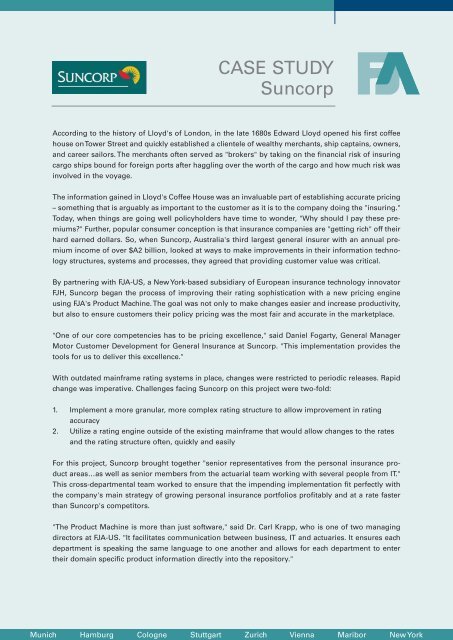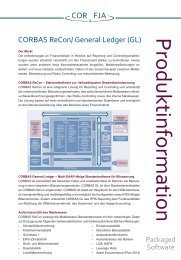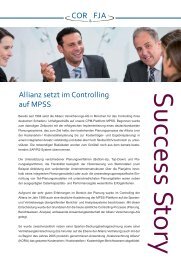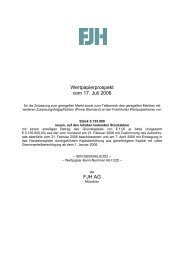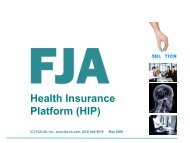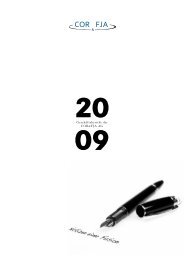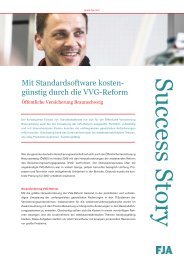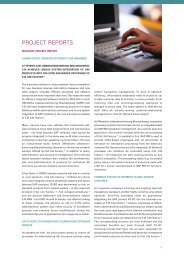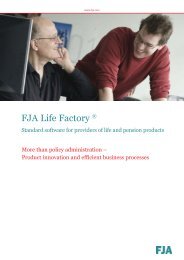CASE STUDY Suncorp
CASE STUDY Suncorp
CASE STUDY Suncorp
You also want an ePaper? Increase the reach of your titles
YUMPU automatically turns print PDFs into web optimized ePapers that Google loves.
<strong>CASE</strong> <strong>STUDY</strong><br />
<strong>Suncorp</strong><br />
According to the history of Lloyd's of London, in the late 1680s Edward Lloyd opened his first coffee<br />
house on Tower Street and quickly established a clientele of wealthy merchants, ship captains, owners,<br />
and career sailors. The merchants often served as "brokers" by taking on the financial risk of insuring<br />
cargo ships bound for foreign ports after haggling over the worth of the cargo and how much risk was<br />
involved in the voyage.<br />
The information gained in Lloyd's Coffee House was an invaluable part of establishing accurate pricing<br />
– something that is arguably as important to the customer as it is to the company doing the "insuring."<br />
Today, when things are going well policyholders have time to wonder, "Why should I pay these premiums?"<br />
Further, popular consumer conception is that insurance companies are "getting rich" off their<br />
hard earned dollars. So, when <strong>Suncorp</strong>, Australia's third largest general insurer with an annual premium<br />
income of over $A2 billion, looked at ways to make improvements in their information technology<br />
structures, systems and processes, they agreed that providing customer value was critical.<br />
By partnering with FJA-US, a New York-based subsidiary of European insurance technology innovator<br />
FJH, <strong>Suncorp</strong> began the process of improving their rating sophistication with a new pricing engine<br />
using FJA's Product Machine. The goal was not only to make changes easier and increase productivity,<br />
but also to ensure customers their policy pricing was the most fair and accurate in the marketplace.<br />
"One of our core competencies has to be pricing excellence," said Daniel Fogarty, General Manager<br />
Motor Customer Development for General Insurance at <strong>Suncorp</strong>. "This implementation provides the<br />
tools for us to deliver this excellence."<br />
With outdated mainframe rating systems in place, changes were restricted to periodic releases. Rapid<br />
change was imperative. Challenges facing <strong>Suncorp</strong> on this project were two-fold:<br />
1. Implement a more granular, more complex rating structure to allow improvement in rating<br />
accuracy<br />
2. Utilize a rating engine outside of the existing mainframe that would allow changes to the rates<br />
and the rating structure often, quickly and easily<br />
For this project, <strong>Suncorp</strong> brought together "senior representatives from the personal insurance product<br />
areas…as well as senior members from the actuarial team working with several people from IT."<br />
This cross-departmental team worked to ensure that the impending implementation fit perfectly with<br />
the company's main strategy of growing personal insurance portfolios profitably and at a rate faster<br />
than <strong>Suncorp</strong>'s competitors.<br />
"The Product Machine is more than just software," said Dr. Carl Krapp, who is one of two managing<br />
directors at FJA-US. "It facilitates communication between business, IT and actuaries. It ensures each<br />
department is speaking the same language to one another and allows for each department to enter<br />
their domain specific product information directly into the repository."<br />
Munich Hamburg Cologne Stuttgart Zurich Vienna Maribor New York
<strong>Suncorp</strong> Profile:<br />
www.suncorp.com.au<br />
Company Description:<br />
The company known today as <strong>Suncorp</strong> came<br />
into existence in 1996 as <strong>Suncorp</strong> Metway with<br />
the amalgamation of two previously Queensland<br />
government-owned companies, <strong>Suncorp</strong><br />
and QIDC, in addition to Metway Bank. In July<br />
2001, <strong>Suncorp</strong> Metway acquired Australian<br />
Mutual Provident Society's (AMP) general insurance<br />
interests which included the GIO insurance<br />
business. The company was rebranded in<br />
2002 to reflect a simplified name – <strong>Suncorp</strong>.<br />
<strong>Suncorp</strong> is the third largest general insurer in<br />
Australia. The company underwrites insurance<br />
products for the <strong>Suncorp</strong>, GIO, & AMP brands.<br />
Headquartered in Queensland, with 173 <strong>Suncorp</strong><br />
retail outlets (including branches and agencies),<br />
and 57 business banking outlets, across<br />
Australia. <strong>Suncorp</strong> also maintains five major call<br />
centers in Brisbane, Melbourne and Toowoomba,<br />
and 16 claims assessment centers.<br />
Year Established:<br />
<strong>Suncorp</strong> Metway (<strong>Suncorp</strong>, Metway and QIDC)<br />
1996<br />
AMP & GIO Insurance business acquired 2001<br />
<strong>Suncorp</strong> 2002<br />
Number of Employees:<br />
Approximately 8,200<br />
Annual Premium Volume:<br />
General Insurance = $2.5B.<br />
Personal Insurance = $1.1B.<br />
Additional Information:<br />
<strong>Suncorp</strong>'s Corporate Projects Division, in cooperation<br />
with FJA-US, led delivery of the program<br />
in accordance with the Project Governance<br />
Framework. This methodology enables <strong>Suncorp</strong><br />
to select which initiatives to invest in while<br />
ensuring appropriate diligence, visibility, and<br />
predictability of project outcomes. <strong>Suncorp</strong><br />
entered the successful implementation of their<br />
General Insurance Pricing Engine Program in a<br />
national project management competition<br />
(AIPM) winning the Queensland State Project of<br />
the Year and took second place in the national<br />
award competition against engineering, scientific<br />
and industrial projects submitted from across<br />
Australia.<br />
<strong>Suncorp</strong>'s evaluation and decision-making process took ten<br />
months, and involved many vendors, but only two in detail.<br />
Adrian Quinn, <strong>Suncorp</strong>'s General Manager IT Strategy,<br />
Architecture and Security commented that the extensive evaluation<br />
process "proved to be most effective in gaining buy-in<br />
from senior management on the potential this initiative could<br />
provide to the organization. It also built confidence that the<br />
FJA product set could support our immediate and long term<br />
requirements." The evaluation process enabled <strong>Suncorp</strong> to<br />
establish a shortlist of vendors, which included FJA-US.<br />
"A key part of the evaluation and decision-making process was<br />
having vendors implement a specified pricing model (provided<br />
by <strong>Suncorp</strong>) and then demonstrate it in a forum of key<br />
business managers," said Quinn. "Part of that demonstration<br />
was to exercise a number of enhancement scenarios (some of<br />
which were provided beforehand, and some were unannounced).<br />
The objective was to understand the flexibility of the<br />
product and its capability to support 'rapid time to market.'"<br />
<strong>Suncorp</strong> requested a Proof of Concept (POC) from the preferred<br />
vendor/product (FJA-US and The Product Machine). This<br />
POC allowed the business to better understand the product<br />
capabilities plus prove/understand the technology, integration<br />
and scalability aspects.<br />
With the selection of FJA-US as the preferred vendor for this<br />
project, the stage was set for a successful implementation.<br />
"FJA's sole focus is the insurance industry with implementations<br />
in 20 countries," commented Marc Dutton, Managing<br />
Director of FJA-US. "FJA brings both actuarial and IT expertise,<br />
using technology as a facilitator of business problems in<br />
the industry."<br />
Both FJA and <strong>Suncorp</strong> understood that change management<br />
and communication were critical aspects. And, since a key requirement<br />
of the project was to get a common pricing structure<br />
across <strong>Suncorp</strong>'s various brands and distribution channels,<br />
the fact that FJA understood the current differences of<br />
the existing products, pricing and supporting systems was<br />
very important.<br />
"FJA's past experience of delivering similar systems was very<br />
valuable to <strong>Suncorp</strong> during this project," said Dutton. "Our<br />
knowledge of the insurance business in general and of <strong>Suncorp</strong>'s<br />
systems and processes specifically was an integral part<br />
of our ultimate success."
The history of <strong>Suncorp</strong> complicated the management and implementation<br />
of this project considerably. <strong>Suncorp</strong> is actually<br />
the amalgamation of several previously separate entities –<br />
the formerly Queensland government-owned <strong>Suncorp</strong> and<br />
QIDC, Metway Bank, and GIO Insurance. And, the myriad of<br />
systems, platforms and personnel embedded within the company<br />
made it necessary for <strong>Suncorp</strong> to involve both IT and<br />
actuarial personnel in the project. The cross-functional team<br />
established to work with FJA to develop the Pricing Engine<br />
effectively completed one of the largest technology projects<br />
ever undertaken by the company, and this successful implementation<br />
has been recognized in national Australian awards<br />
for excellence in project management.<br />
"FJA follows standard development and implementation processes<br />
focusing on project transparency, keeping the customer<br />
informed and pointing out potential problems early in<br />
the process," said Krapp. "FJA employs trained project management<br />
staff responsible for successful implementations.<br />
Furthermore, FJA employs actuaries that speak the same<br />
language as the actuaries of our customers."<br />
"The [FJA] system supported our needs of being flexible and<br />
fast to implement pricing data changes," Fogarty said. "The<br />
'define and generate' approach was appealing as it minimizes<br />
the programming work required to implement and change<br />
pricing rules, which is critical in a competitive market. We<br />
anticipate that the system will have wider applicability for the<br />
group as a core platform to support other business functions<br />
than pricing."<br />
When it came down to the actual installation, "core product<br />
installation was relatively simple, as the FJA product utilizes<br />
industry standard technology platforms and approaches (e.g.<br />
J2EE)," said Quinn. "Standard integration products, such as<br />
IBM MQ Series, were utilized to provide messaging capability,<br />
thus making the technical integration easier."<br />
"The design and the implementation of the pricing structures<br />
and rules were quite involved, and were further complicated<br />
by the number of existing systems that had to integrate with<br />
the new pricing engine." "The challenge came with the functional<br />
integration – dealing with the differences across all the<br />
various systems involved," Quinn explained. "A strong focus<br />
was required on defining clear 'interface contracts' between all<br />
the components and ensuring they were 'functionally valid'<br />
across the end to end solution. Testing to verify this was<br />
extensive."<br />
FJA-US/FJH Profile:<br />
www.fja-us.com<br />
Company Description:<br />
FJA-US, Inc., combines expertise in actuarial<br />
science and technology to deliver packaged and<br />
custom software solutions for the insurance<br />
industry. The core of FJA's offerings is the Product<br />
Machine, which helps companies shorten<br />
the time and reduce the cost of product development.<br />
FJA also offers Asset Liability and Model<br />
Office System (ALAMOS), sales and service,<br />
illustration, and rating solutions. FJA-US, is<br />
headquartered in New York City, and is a subsidiary<br />
of FJH AG, Munich, Germany.<br />
FJH AG is a leading consulting and software firm<br />
for the insurance and pensions market. FJH's core<br />
software product is FJA Life Factory ® , which<br />
enables pension and insurance products to be<br />
developed, marketed and administered. FJH<br />
also produces risk management systems and<br />
portal solution, as well as an extensive portfolio<br />
of services ranging from the implementation<br />
and testing of software through to data migration<br />
and consulting in all matters relating to pensions<br />
provision. The FJH Group and its subsidiaries<br />
provide products and consultancy services<br />
to more than 1,000 companies, including insurance<br />
companies, industrial entities, professional<br />
pension funds and individuals, associations, trade<br />
unions, ministries and government authorities.<br />
Year Established:<br />
FJH (parent company) 1980<br />
FJA-US (New York) 1996<br />
Number of Employees:<br />
650<br />
Additional Information:<br />
As a subsidiary of FJH AG, FJA-US has a powerful<br />
base of knowledge and expertise. FJH has offices<br />
in Hamburg, Cologne and Stuttgart, and additional<br />
subsidiaries in Switzerland, Austria, the<br />
United States, and Slovenia. The company was<br />
listed in February 2000 and was included in the<br />
TechDAX premium index in March 2003.
To fit <strong>Suncorp</strong>'s varied needs, the FJA product set was implemented<br />
on a HP-UX operating platform (HP 9000 Series 800)<br />
using an Oracle database. The actual Pricing Engine application<br />
runs in a BEA Web Logic Server application server environment,<br />
while development tools are deployed to the desktop<br />
via Citrix. The Pricing Engine integrates with several of<br />
<strong>Suncorp</strong>'s core business systems, some of which are IBM<br />
mainframe-based, while others are front-end sales systems<br />
used remotely by various insurance intermediaries, agents,<br />
and brokers.<br />
"The program achieved its goals of improved service, increased<br />
profitability and a competitive leap forward for <strong>Suncorp</strong>,"<br />
Fogarty concluded. "While the program still has several important<br />
milestones to meet as the Pricing Engine is rolled out<br />
across our insurance products, it has provided us with a solid<br />
technologically superior base which we will capitalize on over<br />
the following years. Overall, it positions the business well to<br />
price personal insurance products competitively and profitably,<br />
providing good value for customers and shareholders<br />
alike."<br />
"FJA has a strong understanding and knowledge of insurance<br />
products and processes," concluded Dutton. "This has aided<br />
in the success of developing pointed solutions for the insurance<br />
space. We do not look at technology as a silver bullet,<br />
however, through understanding the problems, we use technology<br />
to facilitate business problems and provide operational<br />
and distribution efficiencies utilizing our offerings. Our<br />
value proposition is to empower insurance companies to be<br />
vendor independent. We want our customers to come back to<br />
FJA because they want to, not because they have to."<br />
CONTACT<br />
FJA-US, Inc.<br />
A Company of the FJH Group<br />
512 Seventh Avenue 15th Flr.<br />
New York NY 10018 USA<br />
Telephone 212 8402618<br />
Telefax 212 8402693<br />
Internet www.fja-us.com/us<br />
FJA's Product Machine Technical Specifications<br />
Platform Specifics:<br />
HP-UX operating platform (HP 9000 Series 800)<br />
via an Oracle database<br />
Running in a BEA Web Logic Sever application<br />
server environment<br />
The PDFS development tool is deployed to the<br />
desktop via Citrix<br />
Integration Specifics:<br />
"The challenge came with the functional integration<br />
– dealing with the differences across all the<br />
various systems involved," said Quinn. "A<br />
strong focus was required on defining clear<br />
'interface contracts' between all the components<br />
and ensuring they were 'functionally valid'<br />
across the end to end solution. Testing to verify<br />
this was extensive. The system integrates with a<br />
number of core business systems – some of<br />
these are IBM mainframe based, others are<br />
front-end sales system used remotely by various<br />
insurance intermediaries, agents, and brokers.<br />
These external intermediaries access pricing<br />
engine from these systems using a HTTP/S<br />
request over the Internet, and integration is via<br />
IBM MQ Series to provide messaging capability."<br />
Were there any specific hardware needs?<br />
"Meeting performance targets was critical," said<br />
Quinn. "As the algorithms within the solution<br />
use significant volumes of 'reference data' (rating<br />
data), there is a heavy dependence on<br />
memory caching. The servers are configured<br />
with a significant amount of RAM (2GB) to support<br />
this. The complexity of the calculations involved<br />
means that the processing is very CPU<br />
intensive. Therefore, good CPU throughput was<br />
required to ensure pricing requests were processed<br />
quickly. Each HP-UX Unix server has<br />
2x875 MHz processors."<br />
As per: 04/2005<br />
© Copyright FJH AG, Munich 2005<br />
20050408


